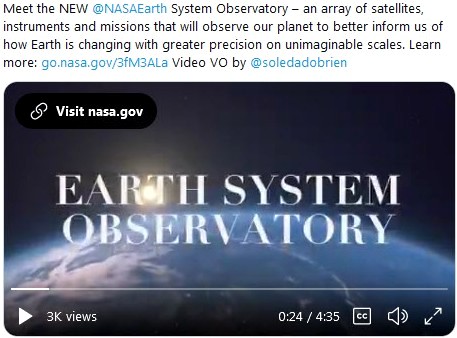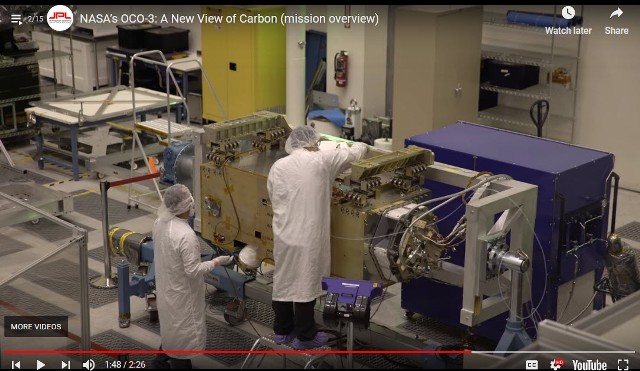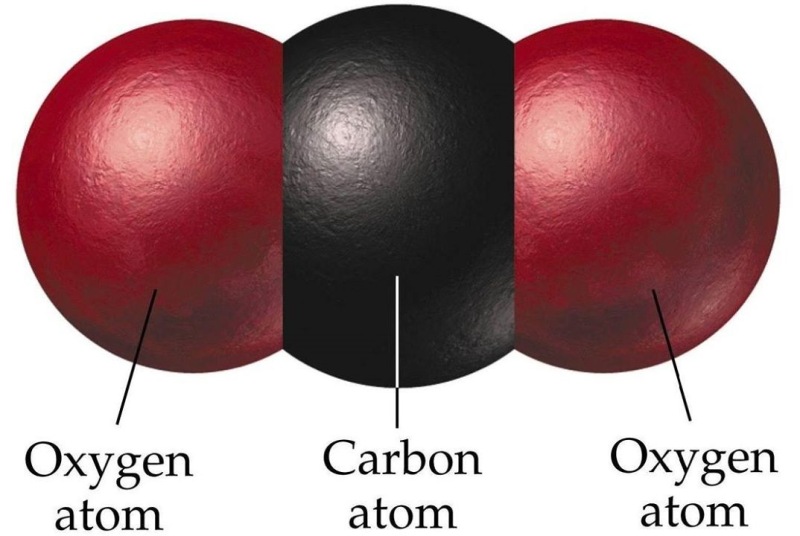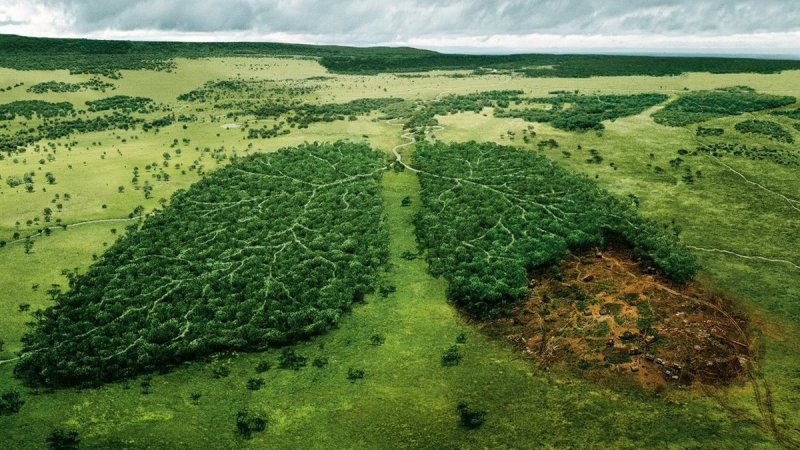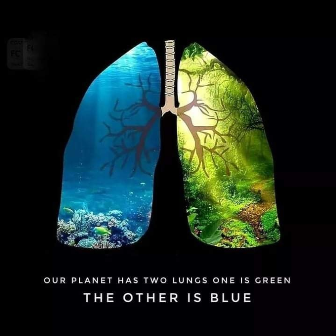File:ThinBlueLayer - June 30 2014.jpg

Original file (527 × 653 pixels, file size: 121 KB, MIME type: image/jpeg)
Now, OCO-3 !
Earth Science to Protect a Sustainable Earth
NASA Earth
NASA: You can manage only what you can measure
Q: What are the main science questions you (JPL/Caltech/NASA) hope OCO-3 will answer?
The big science question is about the movement of carbon dioxide between plants and the atmosphere.
If you look at the ground-based data, it almost looks like the planet is breathing. Plants in the northern hemisphere take up carbon dioxide as they grow in the spring and summer, reducing the amount of CO2 in the atmosphere by a few parts per million. In the fall, the leaves drop and carbon is released back into the air.
But every year is different... What we want to do is find drivers of the plant uptake of carbon and use that to better predict what will happen in the future. If we have a warmer, drier climate, will plants keep taking up as much carbon?
························································
October 2021 / NASA/JPL interview with Annmarie Eldering
Annmarie Eldering: I came out to Los Angeles back in 1988, and it was a great time if you like smoggy, dirty, bad air. So that was what I studied in my Ph.D., was what is it that makes up the air pollution and reduces visibility in L.A.? And then we tried to understand how you could engineer a solution to it. So that was kind of my training and background, and thinking about the world we live in, the world around us, the environmental problems we have, and then how we might try to address them. And that's kind of fed into what I did once I got up to JPL. I went from working in a very local L.A. problem to starting to think about the global picture and global air pollution. And JPL was getting new instruments ready to go into space and study air pollution from space, and that was a great opportunity for me back in 1999.
Host: Hmm.
Annmarie Eldering: So, the first project I joined was called the Tropospheric Emissions Spectrometer. The name doesn't really give away much, but the point was to try to look through Earth's atmosphere and learn about the air pollution, but not just the total amount, but we actually were trying to differentiate air pollution near the surface from air pollution higher up, because it's the stuff near the solution that impacts the humans, so, you want to try to see that separately. And it was a brand-new measurement technique that went up on an EOS (Earth Observing System) mission, and we had a lot of success. And, well, challenges and success with that project. But I learned about doing science from space and working in a NASA team. And then an opportunity arrived back in 2010 to join Orbiting Carbon Observatory-2, and that built nicely on what I had done with TES, so that's the opportunity I had to get involved with the carbon crews, and everything unfolded from there.
Host: The carbon crews, that's a pretty cool name. What is OCO-2?
Annmarie Eldering: OCO-2, Orbiting Carbon Observatory-2, is a follow-on to OCO. The original instrument was a spectrometer built to measure carbon dioxide, but it didn't launch successfully back in 2009. And so, OCO-2 was a rebuild of that instrument, so a spectrometer that they rebuilt, and then they set it up on its own satellite. So OCO-2's actually still out there today, flying over your head and measuring carbon dioxide in Earth's atmosphere from a satellite.
Host: Very interesting. And before we go into OCO-3, which is going to be our primary discussion here, I want to understand more about exactly what it's studying. Because to lead into what exactly the OCO-3 is doing, I think we need to better understand just carbon dioxide, what's happening in the Earth, why is this a field that we actually need to study? So, so let's start there. What is, what is it that OCO-3 is studying? What's happening on Earth?
Annmarie Eldering: Those are great, great questions. And OCO-2 and OCO-3 are, you know, sisters, we kind of, sister instruments using the same technique, measuring the same gases. And carbon dioxide, so a little bit about carbon dioxide: it's this molecule that's in our atmosphere, and it has a particular effect called, we call it the greenhouse gas effect, or it can trap heat and energy. You know what a greenhouse is, maybe you don't know what a greenhouse is, so a greenhouse is where you use glass, you put up a glass building, and sunlight can get in but heat, the longer wavelengths of light, don't get out very well. So even if the air outside the greenhouse is cold, the air inside could be quite warm because the glass is trapping, trapping energy. And so, carbon dioxide molecules do a similar thing. Energy can come into Earth through sunshine, but when it's trying to get back out as heat and longer wavelength radiation, carbon dioxide holds on to some of that. So, it's a little blanket for Earth. And that's kind of a good thing. If that carbon dioxide wasn't there acting as a blanket, we would be way colder, we would not be comfortable here. But if you think about the blanketing effect, you also don't want too much of the blanket on you. The more and more carbon dioxide that gets into our Earth's atmosphere, the more and more it's trapping heat, so it's one of the critical gases to the climate change and the warming of Earth. And in particular, what we want to understand is more about how our human emissions, how much do they stay in Earth's atmosphere, how much do they get taken out by plants that are growing, how much do they absorb in the ocean? Because just for a few little numbers, if we think about how much carbon dioxide humans put into the atmosphere by burning coal and oil and gas, about half of that stays in the atmosphere, typically, and about half of that has been taken out by the oceans and the plants each year. That's over the last decades; as we have measurements, that's what we've seen. But every year's a little bit different. There's these years where the plants and the ocean seem to take out 80% of the carbon dioxide we put in. And then there's other years where they only take out 20%, so it's really variable. And we want to know, how is this going to unfold, what's going to happen in 2050, in 2070? Can the ocean just take up more and more and more and more? Is there going to be some limit? What about the plants? As the plants get warm or it's getting drier, is that going to limit how much carbon dioxide they can take out? So OCO-2 and OCO-3 want to measure carbon dioxide around the whole globe, over oceans, over plants areas, over urban areas -- measure it everywhere and try to put together a more detailed picture of this uptake and release of carbon dioxide from plants and oceans and the atmospheric state. So that was kind of a long story, but that's why we care about carbon dioxide.
Host: Yeah, no, but that's, it's super-interesting. I think this is, what you just described is, you know, where is this carbon dioxide coming from? What is producing it? Where is it being absorbed? Is this the idea of, when I was reading about OCO-3 and what it's measuring, there's these things called carbon dioxide sources and sinks? Is that essentially what you're talking about?
Annmarie Eldering: Yes, it is. That's exactly what I was talking about.
Host: OK.
Annmarie Eldering: The sources and the sinks of carbon dioxide. And also, we use the phrase sometimes about how the Earth breathes because --
Host: Hmm.
Annmarie Eldering: -- when plants get going in the spring, especially you think, if you just imagine a picture of the Earth in your mind and you think the northern hemisphere, North America, Europe, Asia, we have a lot of land in the northern hemisphere. Much more so than down in the southern hemisphere. And when spring arrives in the northern hemisphere, and those plants start growing, you can really see carbon dioxide amounts go down because the plants take it all out of the atmosphere. Or not all, they take a bunch out of the atmosphere. And then when those plants die off in the fall and the winter, that's released back up into the atmosphere. So, you see these swings and sways each year because of plant activity, ups and downs in carbon dioxide concentrations. So that kind of looks like the Earth breathing each spring and fall. But on top of that, we have an overall increase from year to year because we keep putting more carbon dioxide in than the plants and ocean can take out.
Host: Aha.
Annmarie Eldering: And that sources and sinks is this idea of, is, you know, what are the trees and the plants of North America doing? What are they doing in Europe? What are doing in Asia? It's, not every tree and plant is the same, so we want to think about sources and sinks, or uptake and removal, in different regions of the world to understand what exactly they're doing and how they might change in the future.
Planet Citizen Vision of Living Earth
○
File history
Click on a date/time to view the file as it appeared at that time.
| Date/Time | Thumbnail | Dimensions | User | Comment | |
|---|---|---|---|---|---|
| current | 17:43, 13 October 2021 |  | 527 × 653 (121 KB) | Siterunner (talk | contribs) |
You cannot overwrite this file.
File usage
The following page uses this file:
- Anthropocene
- Atmosphere
- Atmospheric Science
- Democratization of Space
- Earth360
- EarthPOV
- Earth Observations
- Earth Science
- Environmental Protection
- Environmental Security
- EOS eco Operating System
- Ecology Studies
- Eco-Quotes
- Eco-Spirituality
- Global Security
- Green Graphics
- Networking
- New Space
- Orbital Perspective
- Overview Effect
- Planet Citizen
- Planet Citizens
- Planet Scientist
- Planet Citizens, Planet Scientists
- Strategic Demands
- ThinBlueLayer
- Whole Earth
